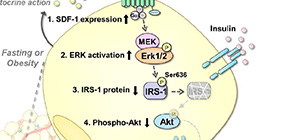
Culprit in reducing effectiveness of insulin identified
Insulin is a hormone made by the pancreas and helps cells to take in glucose from the blood. Insulin binds to insulin receptors to activate Insulin Receptor Substrate 1 (IRS-1), taking in sugar through phosphorylation of Akt. If insulin loses its effectiveness, a bulk of the cells in the body becomes unable to take up glucose and high blood sugar levels persist, leading to diabetes.
A group of researchers led by Atsunori Fukuhara has reported that adipocytokine, or cell signaling proteins secreted by the adipose tissue, played a role in developing obesity. However, it was not known that adipocytokine activated on adipocytes themselves to control insulin sensitivity. SDF-1, one of the adipocytokines, is the most predominantly expressed chemokine; however, its action on glucose uptake in cells had not been analyzed.
Using microarray database analysis, this group of scientists identified SDF-1 as a factor to enhance expression in adipocytes in both fasting and obese states and found that SDF-1 reduced the effectiveness of insulin in adipocytes. In actuality, in SDF-1 knockout mice, insulin-induced glucose uptake increased (i.e., blood sugar levels decreased), and insulin efficacy improved (i.e., insulin sensitivity was enhanced). Their research results were published in Diabetes .
Based on the results of this study, it is expected that insulin sensitivity in adipocytes will increase by inactivating the SDF-1 signaling pathway, which will lead to treatment of obese type 2 diabetes.

Fig.1.
(credit: Osaka University)
1) Fasting or obesity induces SDF-1 expression in adipocytes. 2) Its autocrine action activates ERK signaling. 3) SDF-1–induced ERK signal concomitantly induces serine phosphorylation of IRS-1 protein, and degrades IRS-1 protein. This attenuates 4) insulin-mediated Akt phosphorylation and 5) glucose uptake.
To learn more about this research, please view the full research report entitled "SDF-1 is an autocrine insulin-desensitizing factor in adipocytes" a t this page of Diabetes .
Related links
